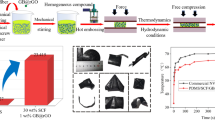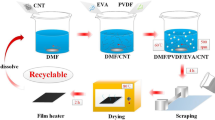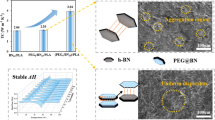Abstract
Phase change materials (PCMs) have been widely used in passive thermal management and energy storage due to their high latent heat capacity. However, the low thermal conductivity and leakage problems of PCMs are two bottlenecks for its application in the field of heat-related applications. Although many present studies can tackle one or two of these problems by preparing phase change composites (PCCs), it is still a challenge to achieve high performance PCCs with excellent thermal, mechanical, and phase change properties simultaneously. In this work, we report a spatial confining forced network assembly (SCFNA) method to efficiently prepare the thermal conductive, flexible, leak-proof hexagonal boron nitride/paraffin wax/ polydimethylsiloxane (hBN/PW/PDMS) PCCs by constructing hBN and PW thermal conductive networks as the functional matrix of PCCs. In the hBN/PW/PDMS PCCs, PW is served as the PCM, a dense hBN network provides the high thermal conductivity, and the mechanical properties and shape stability are provided by PDMS. The hBN/PW/PDMS PCCs as thermal interface materials reduce the LED chips surface temperature and exhibit efficient and reliable thermal management performance. Our work provides an efficient and economical method for the preparation of PCCs with outstanding thermal management capability.







Similar content being viewed by others
Data availability
Data will be made available on request.
References
Si W et al (2020) Enhancing thermal conductivity via conductive network conversion from high to low thermal dissipation in polydimethylsiloxane composites. J Mater Chem C 8(10):3463–3475
He X et al (2019) Enhancing thermal conductivity of polydimethylsiloxane composites through spatially confined network of hybrid fillers. Compos Sci Technol 172:163–171
Zhang X et al (2021) Highly thermally conductive and electrically insulating polydimethylsiloxane composites prepared by ultrasonic-assisted forced infiltration for thermal management applications. Compos Part B Eng 224
Feng Y et al (2018) Advanced metal oxides and nitrides thermoelectric materials for energy harvesting. ES Mater Manuf
Gu J, Ruan K (2021) Breaking through bottlenecks for thermally conductive polymer composites: A perspective for intrinsic thermal conductivity, interfacial thermal resistance and theoretics. Nano-Micro Lett 13(1)
He X et al (2021) A mini review on factors affecting network in thermally enhanced polymer composites: filler content, shape, size, and tailoring methods. Adv Compos Hybrid Mater 5(1):21–38
Zhang H et al (2020) Thermal conductivity enhancement via conductive network conversion from “sand-like” to “stone-like” in the polydimethylsiloxane composites. Compos Commun 22
Wang J et al (2021) Preparation of flexible and elastic thermal conductive nanocomposites via ultrasonic-assisted forced infiltration. Compos Sci Technol 202
Gong S et al (2021) High thermal conductivity and mechanical strength phase change composite with double supporting skeletons for industrial waste heat recovery. ACS Appl Mater Interfaces 13(39):47174–47184
Wu S et al (2020) Highly thermally conductive and flexible phase change composites enabled by polymer/graphite nanoplatelet-based dual networks for efficient thermal management. J Mater Chem A 8(38):20011–20020
Yang G et al Boron nitride microsheets bridged with reduced graphene oxide as scaffolds for multifunctional shape stabilized phase change materials. Solar Energy Mater Solar Cells 209
Luo F et al (2022) Shape-stabilized phase change materials with superior thermal conductivity for thermal energy harvesting. ACS Appl Polym Mater 4(3):2160–2168
Kumar PM et al (2020) Experimental and theoretical investigations on thermal conductivity of the paraffin wax using CuO nanoparticles. Mater Today Proc 22:1987–1993
George M et al (2020) A novel polyaniline (PANI)/ paraffin wax nano composite phase change material: Superior transition heat storage capacity, thermal conductivity and thermal reliability. Sol Energy 204:448–458
Xie Y et al (2021) Paraffin/polyethylene/graphite composite phase change materials with enhanced thermal conductivity and leakage-proof. Adv Compos Hybrid Mater 4(3):543–551
Li X et al (2021) Multifunctional HDPE/CNTs/PW composite phase change materials with excellent thermal and electrical conductivities. J Mater Sci Technol 86:171–179
Huang J et al (2021) Advances and applications of phase change materials (PCMs) and PCMs-based technologies. ES Mater Manuf
Lu X et al (2020) Polyethylene glycol/carbon black shape-stable phase change composites for peak load regulating of electric power system and corresponding thermal energy storage. Eng Sci
Qian T et al (2018) Comparative study of single-walled carbon nanotubes and graphene nanoplatelets for improving the thermal conductivity and solar-to-light conversion of PEG-infiltrated phase-change material composites. ACS Sustain Chem Eng 7(2):2446–2458
Li M, Wang C (2019) Preparation and characterization of GO/PEG photo-thermal conversion form-stable composite phase change materials. Renew Energy 141:1005–1012
Tu J et al (2019) Latent heat and thermal conductivity enhancements in polyethylene glycol/polyethylene glycol-grafted graphene oxide composites. Adv Compos Hybrid Mater 2(3):471–480
Rathore PKS, Shukla SK (2021) Enhanced thermophysical properties of organic PCM through shape stabilization for thermal energy storage in buildings: A state of the art review. Energy Build 236
Lamrani B et al (2021) A simplified thermal model for a lithium-ion battery pack with phase change material thermal management system. J Energy Storage 44
Wu W et al (2015) Preparation and thermal conductivity enhancement of composite phase change materials for electronic thermal management. Energy Convers Manag 101:278–284
Nagar S, Sharma K (2020) Modern solar systems driven by nanoparticles-based fatty acids and paraffin wax phase change materials. J Mater Sci 56(8):4941–4966
Pan D et al (2022) Vertically aligned silicon carbide nanowires/boron nitride cellulose aerogel networks enhanced thermal conductivity and electromagnetic absorbing of epoxy composites. Nano-Micro Lett 14(1)
Kormakov S et al (2018) A mathematical model for predicting conductivity of polymer composites with a forced assembly network obtained by SCFNA method. Polym Compos 40(5):1819–1827
Xiang J, Drzal LT (2011) Investigation of exfoliated graphite nanoplatelets (xGnP) in improving thermal conductivity of paraffin wax-based phase change material. Sol Energy Mater Sol Cells 95(7):1811–1818
Yan X et al (2020) Efficient solvent-free microwave irradiation synthesis of highly conductive polypropylene nanocomposites with lowly loaded carbon nanotubes. ES Mater Manuf
Jadhav PR et al (2020) Mechanical behavior and fractography of graphite and boron carbide particulates reinforced A356 alloy hybrid metal matrix composites. Adv Compos Hybrid Mater 3(1):114–119
Zhou Y, Liu F, Chen C-Y (2019) Use of BN-coated copper nanowires in nanocomposites with enhanced thermal conductivity and electrical insulation. Adv Compos Hybrid Mater 2(1):46–50
Zhang X et al (2021) Constructing dual thermal conductive networks in electrospun polyimide membranes with highly thermally conductivity but electrical insulation properties. Adv Compos Hybrid Mater 4(4):1102–1112
Guo Y et al (2019) Reduced graphene oxide heterostructured silver nanoparticles significantly enhanced thermal conductivities in hot-pressed electrospun polyimide nanocomposites. ACS Appl Mater Interfaces 11(28):25465–25473
Fang X et al (2014) Thermal energy storage performance of paraffin-based composite phase change materials filled with hexagonal boron nitride nanosheets. Energy Convers Manag 80:103–109
Liu C et al (2020) Remarkably reduced thermal contact resistance of graphene/olefin block copolymer/paraffin form stable phase change thermal interface material. Int J Heat Mass Transf 163
Qian Z et al (2018) Phase change materials of paraffin in h-BN porous scaffolds with enhanced thermal conductivity and form stability. Energy Build 158:1184–1188
Luo J et al (2022) Battery thermal management systems (BTMs) based on phase change material (PCM): A comprehensive review. Chem Eng J 430
Javadi FS, Metselaar HSC, Ganesan P (2020) Performance improvement of solar thermal systems integrated with phase change materials (PCM), a review. Sol Energy 206:330–352
Kalbasi R (2021) Introducing a novel heat sink comprising PCM and air - Adapted to electronic device thermal management. Int J Heat Mass Transf 169
Rathore PKS, Shukla SK (2021) Improvement in thermal properties of PCM/Expanded vermiculite/expanded graphite shape stabilized composite PCM for building energy applications. Renew Energy 176:295–304
Safdari M, Ahmadi R, Sadeghzadeh S (2020) Numerical investigation on PCM encapsulation shape used in the passive-active battery thermal management. Energy 193
Zhou Y et al (2020) Recent advances in thermal interface materials. ES Mater Manuf
Bai L et al (2018) Effect of PLA crystallization on the thermal conductivity and breakdown strength of PLA/BN composites. ES Mater Manuf
Du Q et al (2022) Skeleton designable SGP/EA resin composites with integrated thermal conductivity, electromagnetic interference shielding, and mechanical performances. Compos Sci Technol 229
Wang L et al (2019) Electromagnetic interference shielding MWCNT-Fe3O4@Ag/epoxy nanocomposites with satisfactory thermal conductivity and high thermal stability. Carbon 141:506–514
Cheng H et al (2021) PVDF-Ni/PE-CNTs composite foams with co-continuous structure for electromagnetic interference shielding and photo-electro-thermal properties. Eng Sci
Jing X et al (2022) Improving thermal conductivity of polyethylene/polypropylene by styrene-ethylene-propylene-styrene wrapping hexagonal boron nitride at the phase interface. Adv Compos Hybrid Mater
Chen J et al (2017) Vertically aligned and interconnected boron nitride nanosheets for advanced flexible nanocomposite thermal interface materials. ACS Appl Mater Interfaces 9(36):30909–30917
Zhang H et al (2022) Synergistic enhanced thermal conductivity of polydimethylsiloxane composites via introducing SCF and hetero-structured GB@rGO hybrid fillers. Adv Compos Hybrid Mater
Chen C et al (2015) Novel form stable phase change materials based on the composites of polyethylene glycol/polymeric solid-solid phase change material. Sol Energy Mater Sol Cells 134:80–88
Yang J et al (2016) Experimental study on enhancement of thermal energy storage with phase-change material. Appl Energy 169:164–176
Park J, Kim T, Leigh S-B (2014) Application of a phase-change material to improve the electrical performance of vertical-building-added photovoltaics considering the annual weather conditions. Sol Energy 105:561–574
Guo Y, Ruan K, Gu J (2021) Controllable thermal conductivity in composites by constructing thermal conduction networks. Mater Today Phys 20
Mills A et al (2006) Thermal conductivity enhancement of phase change materials using a graphite matrix. Appl Therm Eng 26(14–15):1652–1661
Zhang Z et al (2018) Experimental investigation on n–octadecane/polystyrene/expanded graphite composites as form–stable thermal energy storage materials. Energy 157:625–632
Sun J et al (2021) The contribution of conductive network conversion in thermal conductivity enhancement of polymer composite: a theoretical and experimental study. ES Mater Manuf
Sun J et al (2019) Development and application of hot embossing in polymer processing: A review. ES Mater Manuf
Wang S et al (2020) Optimal analysis for thermal conductivity variation of EVA/SCF composites prepared by spatial confining forced network assembly. Mater Today Commun 25
Zhang X et al (2021) Influence of rigid particles on thermal conductivity enhancement of polydimethylsiloxane composite during spatial confining forced network assembly. J Appl Polym Sci 139(8)
Du Y et al (2021) Efficient construction and online evaluation of conductive networks within polydimethylsiloxane composites via continuous SCFNA method. Compos Commun 24
Wu D et al (2017) Spatial Confining Forced Network Assembly for preparation of high-performance conductive polymeric composites. Compos A Appl Sci Manuf 102:88–95
Zhuang J et al (2018) Fabrication and testing of metal/polymer microstructure heat exchangers based on micro embossed molding method. Microsyst Technol 25(2):381–388
Kormakov S et al (2019) The electrical conductive behaviours of polymer-based three-phase composites prepared by spatial confining forced network assembly. Express Polym Lett 13(8):713–723
Du Q et al (2022) Preparation of PP/ SCF thermally conductive composites with forced‐assembled networks by multiple injection compression molding. J Appl Polym Sci 139(34)
Li C et al (2022) Construction of bi-continuous structure in fPC/ABS-hBN(GB) composites with simultaneous enhanced thermal conductivity and mechanical properties. Compos Sci Technol 223
Wu H et al (2020) Polydimethylsiloxane/multi-walled carbon nanotube nanocomposite film prepared by ultrasonic-assisted forced impregnation with a superior photoacoustic conversion efficiency of 9.98 × 10−4. J Nanophotonics 14(04)
Gao Q et al (2021) Flexible multilayered MXene/thermoplastic polyurethane films with excellent electromagnetic interference shielding, thermal conductivity, and management performances. Adv Compos Hybrid Mater 4(2):274–285
Cheng H et al (2021) Ultrathin flexible poly(vinylidene fluoride)/MXene/silver nanowire film with outstanding specific EMI shielding and high heat dissipation. Adv Compos Hybrid Mater 4(3):505–513
Zhang J et al (2023) Block copolymer functionalized quartz fibers/cyanate ester wave-transparent laminated composites. J Mater Sci Technol 139:189–197
Agarwal A, Sarviya RM (2017) Characterization of commercial grade paraffin wax as latent heat storage material for solar dryers. Mater Today Proc 4(2):779–789
Acknowledgements
The authors thank the financial supports from National Natural Science Foundation of China (No. 52003019), Sinopec key projects (No. 420043-6), and Talents Introduction Project in Beijing University of Chemical Technology (No. buctrc201909).
Author information
Authors and Affiliations
Corresponding authors
Ethics declarations
Conflict of interest
There is no conflict to declare.
Additional information
Publisher's Note
Springer Nature remains neutral with regard to jurisdictional claims in published maps and institutional affiliations.
Supplementary Information
Below is the link to the electronic supplementary material.
Rights and permissions
Springer Nature or its licensor (e.g. a society or other partner) holds exclusive rights to this article under a publishing agreement with the author(s) or other rightsholder(s); author self-archiving of the accepted manuscript version of this article is solely governed by the terms of such publishing agreement and applicable law.
About this article
Cite this article
Du, Q., Li, C., Sun, J. et al. Efficient preparation of polydimethylsiloxane-based phase change composites by forced network assembly with outstanding thermal management capability. J Polym Res 30, 158 (2023). https://doi.org/10.1007/s10965-023-03553-5
Received:
Accepted:
Published:
DOI: https://doi.org/10.1007/s10965-023-03553-5




